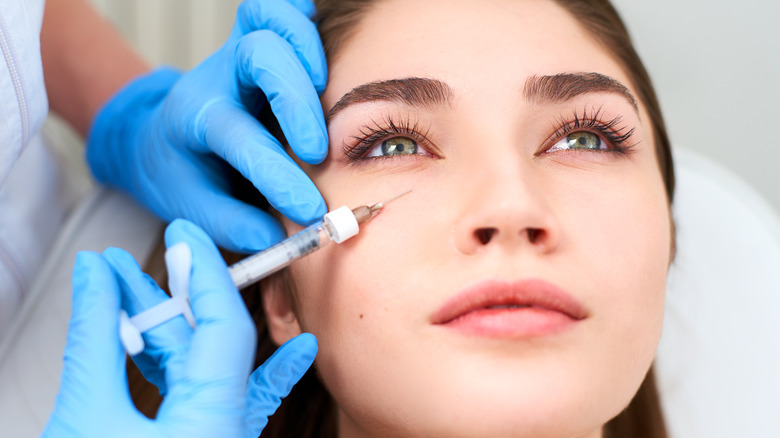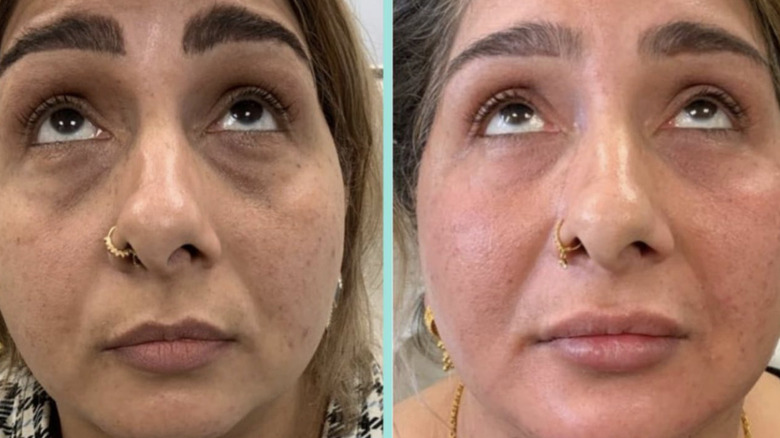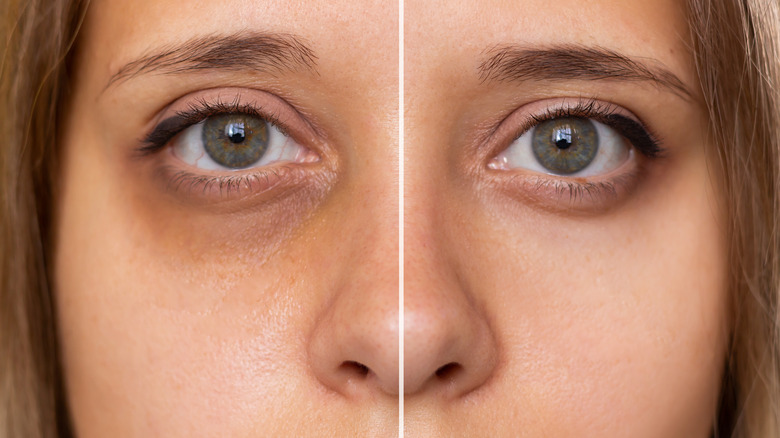What You Should Know Before Getting Under-Eye Fillers
In a world of filters and photoshop, it's normal to long for a face with no imperfections. The truth is that most people on the 'gram with flawless skin get a little help, whether that's digital assistance in the form of editing or cosmetic work to iron out imperfections. While it's totally okay to rock your skin the way it is, it's also fine to address issues that make you feel less confident, like lines and discoloration under the eyes. Under-eye filler is a popular course of action for those with hollowness under the eye, which leads to dark circles or a shadow effect (via Self).
Medical News Today explains that dermal fillers, which are also called soft tissue fillers, add volume to the skin through the injection of substances such as hyaluronic acid, polylactic acid, and calcium hydroxylapatite. Not to be confused with Botox, which treats dynamic wrinkles by targeting the muscles near them, fillers remedy hollowness and wrinkles by plumping up the skin (via Healthline). Under-eye fillers can dramatically improve the appearance of the under-eye area, known as the tear trough, giving you a much-deserved confidence boost. But this treatment isn't right for everyone, and there are several factors to consider before you book your appointment.
What under-eye fillers do (and don't do)
Under-eye fillers can successfully treat under-eye shadow and pseudoherniation of orbital fat, which presents as puffy eye bags. But not all skin issues can be treated with dermal fillers. Glamour points out that under-eye fillers only fix dark circles under the eyes when that discoloration is caused by volume loss or natural hollowness. Fillers won't help dark circles that are caused by pigmentation, or darker pigment in your skin.
In fact, under-eye fillers would only emphasize this kind of shadow. The good news is any qualified dermatologist or plastic surgeon will be able to identify the cause of your dark circles at your consultation. To treat dark circles that aren't caused by volume loss, you can commit to sun protection and getting enough sleep, along with topical treatments that contain ingredients such as caffeine and B vitamins.
Once you've determined that under-eye fillers can successfully address your concerns, the next consideration to be aware of is the price, which can be hefty. All About Vision explains that this type of filler is priced per syringe and overall costs vary depending on how many syringes a patient needs. Other factors that can affect the cost include the brand of filler and the price structure used by the dermatologist. According to the American Society of Plastic Surgeons (via All About Vision), the average cost of hyaluronic acid filler is $652 per syringe. The good news is that results may be visible immediately, though potentially unclear at first if you have swelling or redness.
Are there any side effects to under-eye fillers?
Receiving under-eye filler is usually a quick process taking no longer than an hour. DermCollective explains that many dermatologists apply topical numbing cream before administering the injections, which decreases pain. However, some people may find the thought of a needle or cannula so close to their eye daunting. It's also important to note that under-eye fillers are not permanent. They slowly dissolve over time, usually lasting anywhere from 12 to 18 months (via Cosmopolitan).
Like most medical and cosmetic treatments, under-eye fillers are not free from potential side effects. Healthline highlights that the most common side effects include redness and puffiness of the under-eye area, a small red dot at the injection site, and bruising. The Tyndall effect is another side effect that occurs when the filler is injected too close to the skin's surface, resulting in puffiness or blue coloring. Dermatologists can rectify this by dissolving the filler, usually via the injection of another substance. But in the majority of cases, most side effects go away on their own.
More serious potential complications include post-procedure infection which can develop up to six months after the appointment, vascular occlusions which occur when the filler is accidentally injected into an artery, and partial or full blindness due to the puncturing of a blood vessel. While possible, these complications are rare and less likely if you use a qualified and experienced provider. In most cases, under-eye filler can dramatically improve imperfections while only causing mild, short-lived side effects.


